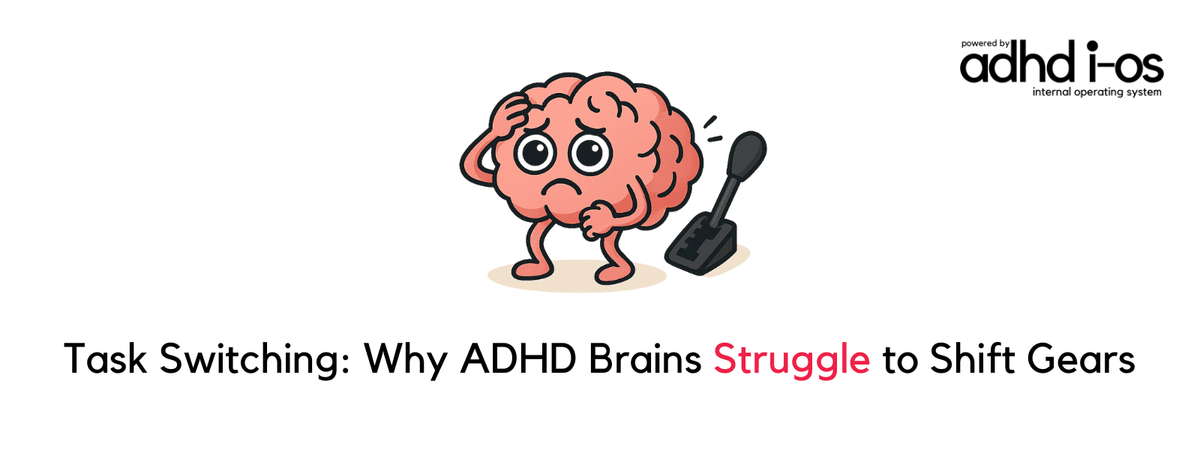Task Switching: Why ADHD Brains Struggle to Shift Gears
Task Switching: Why ADHD Brains Struggle to Shift Gears
Task Switching: Why ADHD Brains Struggle to Shift Gears
Ever try to move from one task to another and feel like your brain just...won’t budge? You stare. You fidget. You get up and walk around. But that next step? It won’t land.
It’s not procrastination; it’s neurology.
For ADHD brains, shifting focus can feel like trying to change gears in a jammed transmission.
Let’s unpack what task switching really means, why it feels impossible sometimes, and how to make smoother transitions that work with your brain, not against it.

What Is Task Switching?
Task switching – also called cognitive flexibility – is your brain’s ability to stop one activity and start another. It’s what lets you pivot from a Zoom call to writing a report. Or from making dinner to helping with homework.
But here’s the catch: task switching isn’t multitasking.
Multitasking tries to juggle multiple things at once (which science says we’re all pretty bad at). Task switching is about mentally letting go of one thing so you can fully engage with the next.
Think of it like driving a car. A neurotypical brain switches gears easily. An ADHD brain? The gear shift sticks. Every transition requires a bit more muscle, and a lot more intention.
Related Read: Executive Function & ADHD Explained
The Brain Behind the Shift: What’s Actually Going On
ADHD brains don’t disengage easily. That’s not a motivation problem, it’s a brain wiring issue. Here’s what the science says:
Prefrontal Cortex Under-Activates
The prefrontal cortex (PFC) is your brain’s “task manager.” It tells you when to stop, start, and shift. In ADHD, this system, especially in the ventrolateral and medial regions, is often underactive.
Result? You stay mentally stuck, even when you want to move on.
Low Dopamine & Norepinephrine
These brain chemicals are responsible for alertness and motivation. When they’re low (as they often are in ADHD), it’s harder for your brain to “reboot” for the next task.
Cognitive Load Builds Faster
ADHD brains tend to collect and carry more mental residue from previous tasks, making transitions feel heavier. It’s like walking through molasses to get to your next to-do.
Why Task Switching Feels So Hard
- You’re in the middle of drafting an email, then need to answer a Slack message. Suddenly, both feel overwhelming.
- You finish dinner but can’t bring yourself to clean the kitchen.
- You stare at your to-do list, knowing the next task… just won’t start.
These aren’t random quirks. They’re patterns of ADHD cognition:
- Cliff-like transitions (there’s no smooth ramp to the next task)
- Mental looping (stuck replaying the last thing you did)
- Avoidance or shutdown (too much friction to switch gears)
Studies confirm: ADHD is linked to lower cognitive flexibility and higher switch cost, meaning your brain works harder to pivot than most.
The True Cost of Poor Task Switching
Every switch has a cognitive cost (e.g. time, energy, and attention lost in the transition). In ADHD brains, that cost is higher.
- More mistakes
- More time wasted
- More mental exhaustion
- More frustration and self-criticism
This leads to burnout, avoidance, and the dreaded feeling of "Why can’t I just DO the thing?"
ADHD-Smart Strategies That Actually Help
Here’s what research and real-life ADHD brains agree on: you can train your brain to shift better with the right tools.
- Strategy - Transition Rituals
- Why It Works - Counting down, standing up, or a specific gesture gives your brain a signal to switch.
- Strategy - Doorway Cues
- Why It Works - Physically moving locations helps mark the end of one task and start of the next.
- Strategy - Pre-Plan Next Task
- Why It Works - Writing down the first step of what’s next reduces mental resistance and decision fatigue.
- Strategy - Sensory Anchors
- Why It Works - Music, timers, or scents can activate your arousal system and help you “shift states.”
- Strategy - Mini-Shift Steps
- Why It Works - Break big shifts into smaller transitions. Your brain doesn’t have to leap; it just needs to step.
Your Brain Isn’t Broken, It’s Just Built Differently
Struggling to switch tasks doesn’t mean you’re lazy or undisciplined. It means your brain has different demands for transition and different tools to meet them.
Try one strategy today. Maybe it’s a countdown. Maybe it’s walking to another room before your next task. Notice how even a small shift can open a stuck loop.
And if you want to explore more brain-supportive tools, join us at adhd i-os, where we build strategies that actually fit the way your brain works.

